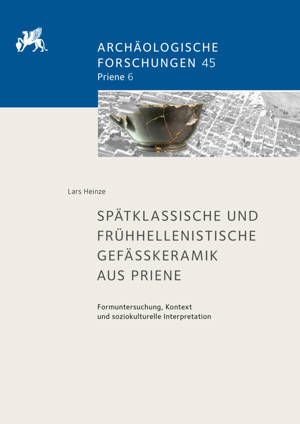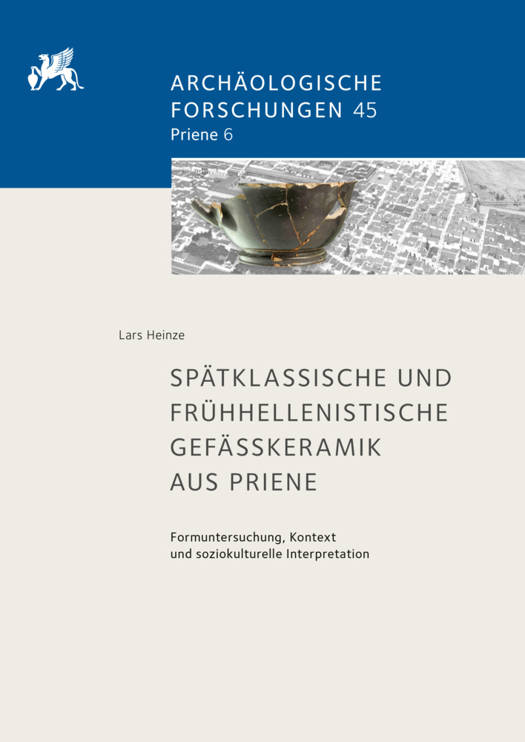
- Retrait gratuit dans votre magasin Club
- 7.000.000 titres dans notre catalogue
- Payer en toute sécurité
- Toujours un magasin près de chez vous
- Retrait gratuit dans votre magasin Club
- 7.000.0000 titres dans notre catalogue
- Payer en toute sécurité
- Toujours un magasin près de chez vous
Spatklassische Und Fruhhellenistische Gefasskeramik Aus Priene
Formuntersuchung, Kontext Und Soziokulturelle Interpretation
Lars Heinze
221,45 €
+ 442 points
Description
English summary: Pottery from the 4th and 3rd centuries BCE from excavations in Asia Minor is still sparsely investigated, which is why the presentation of selected late Classical and early Hellenistic contexts from Priene, founded in the middle of the 4th century BCE, will be an important reference group for future research in the region. The typologically and chronologically processed pottery is furthermore examined regarding various aspects of cultural and economic history. These results are based on scientific investigation methods (portable ED-XRF and petrography) that were carried out on a representative selection of fragments. Pottery investigations are central to explore trade connections within the Eastern Mediterranean. For this, the share that certain imports make up in relation to local and regional production is of special interest. It can be shown that there are considerable differences between the various classes of ceramics, with the high proportion of imported cooking wares being particularly surprising. Aspects of value, both material and ideal, are also examined. This can be seen in imported Attic vessels, which must have been in use for at least 25 years at the time of their disposal and were therefore probably brought with them by their owners from the old city when they moved. In addition, the potential of the pottery under study for determining the time when the city has been founded and evidence of ancient waste management are further areas of investigation. German description: Gefasskeramik des 4. und 3. Jhs. v. Chr. aus kleinasiatischen Grabungen stellt in mehrfacher Hinsicht eine hochst aussagekraftige Fundgattung dar. Sie ist aber noch immer nur sparlich untersucht, weshalb die Vorlage der hier prasentierten spatklassischen und fruhhellenistischen Fundkontexte aus dem in der Mitte des 4. Jhs. v. Chr. gegrundeten Priene eine wichtige Referenzgruppe fur zukunftige Untersuchungen in der Region darstellt. Das typologisch und chronologisch aufgearbeitete Material wird nicht nur unter Gesichtspunkten der Keramikforschung im engeren Sinne, sondern auch hinsichtlich verschiedener kultur- und wirtschaftsgeschichtlicher Aspekte untersucht. Die Ergebnisse grunden dabei nicht zuletzt auf naturwissenschaftlichen Untersuchungsverfahren (portable ED-RFA und Petrografie), die an einer reprasentativen Auswahl an Fragmenten vorgenommen wurden. Von zentraler Bedeutung ist Gefasskeramik u. a. hinsichtlich der daraus abzuleitenden Handelsverbindungen im ostlichen Mittelmeerraum. Dabei interessiert auch der Anteil, den die Importe im Verhaltnis zur lokalen und regionalen Produktion ausmachen. Hier zeigen sich beachtliche Unterschiede zwischen verschiedenen Keramikgattungen, wobei vor allem der hohe Anteil importierter Kochkeramik im fruhen Priene uberrascht. Auch Aspekte der Wertschatzung, sowohl materiell wie auch ideell, werden angesprochen. Besonders ergiebig scheinen hierfur die importierten attischen Gefasse, die zum Zeitpunkt ihrer Deponierung mitunter 25 Jahre oder alter gewesen sein mussen und von ihren Besitzern beim Umzug in die neue Stadt mitgebracht worden sein mussen. Weitere Untersuchungsbereiche sind das Aussagepotential der Fundkeramik bei der Eingrenzung der Grundungszeit der Stadt sowie Indizien fur ein antikes Abfallmanagement.
Spécifications
Parties prenantes
- Auteur(s) :
- Editeur:
Contenu
- Nombre de pages :
- 584
- Langue:
- Allemand
- Collection :
Caractéristiques
- EAN:
- 9783752008562
- Date de parution :
- 23-05-25
- Format:
- Livre relié
- Format numérique:
- Genaaid
- Dimensions :
- 210 mm x 297 mm
- Poids :
- 948 g

Les avis
Nous publions uniquement les avis qui respectent les conditions requises. Consultez nos conditions pour les avis.






